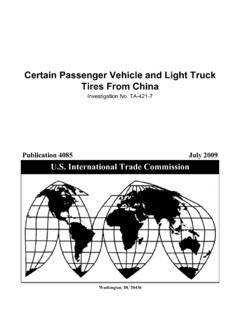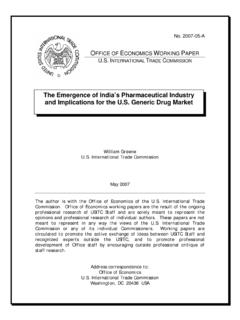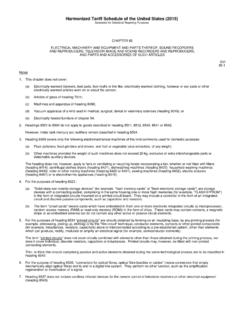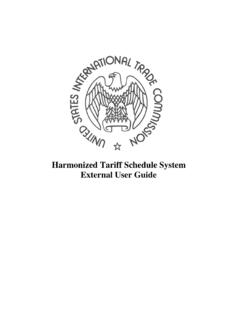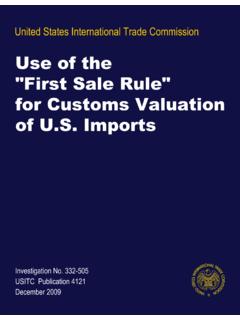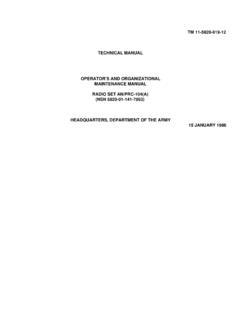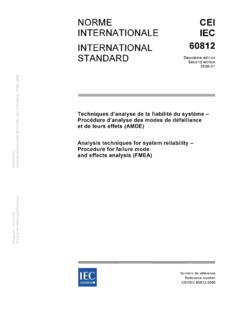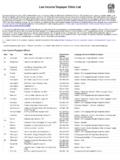Transcription of U.S. International Trade Commission
1 International Trade CommissionCOMMISSIONERSA ddress all communications toSecretary to the CommissionUnited States International Trade CommissionWashington, DC 20436 Jennifer A. HillmanDeanna Tanner Okun, Vice ChairmanMarcia E. MillerStephen Koplan, ChairmanCharlotte R. LaneDaniel R. PearsonPursuant to the letter of request from theUnited States Trade Representative ofDecember 2, 2004, set forth in theAppendix hereto, and pursuant tosection 1207(a) of the Omnibus Tradeand Competitiveness Act, theCommission is publishing the followingmodifications to the Harmonized TariffSchedule of the United States (HTS) toimplement the United States-AustraliaFree Trade Agreement, as approved inthe United States-Australia Free TradeAgreement Implementation IThe HTS is modified as provided below, with bracketed matter included to assist in theunderstanding of proclaimed modifications.
2 The following supersedes matter in theHTS. The subheadings and superior text are set forth in columnar format, and materialin such columns is inserted in the columns of the HTS designated Heading/Subheading , Article Description , Rates of Duty 1 General , Rates of Duty1 Special and Rates of Duty 2", A. Effective with respect to goods that are entered, or withdrawn fromwarehouse for consumption, on or after January 1, 2005, the HTS is hereby modified asfollows:(1).General note 3(c)(i) is modified by inserting, immediately above the line reading Automotive Products , a new line reading: United States-Australia Free Trade Agreement Implementation 2. The following new general note is inserted in numerical sequence: States-Australia Free Trade Agreement Implementation Act.
3 (a)Originating goods under the terms of the United States-Australia Free Trade Agreement (UAFTA) are subject toduty as provided for herein. For the purposes of this note, goods of Australia, as defined in subdivisions (b) through(n) of this note, that are imported into the customs territory of the United States and entered under a provision forwhich a rate of duty appears in the Special subcolumn of column 1 followed by the symbol AU in parenthesesare eligible for the tariff treatment and quantitative limitations set forth in the Special subcolumn, in accordancewith sections 201 through 203, inclusive, of the United States-Australia Free Trade Agreement Implementation Act( 108-286; 118 Stat.)
4 919). For the purposes of this note, the term UAFTA country refers only to Australia orto the United States.(b)For the purposes of this note, subject to the provisions of subdivisions (c), (d), (m) and (n) thereof, a good importedinto the customs territory of the United States is eligible for treatment as an originating good of a UAFTA countryunder the terms of this note only if --(i)the good is a good wholly obtained or produced entirely in the territory of Australia or of the United States, orboth;(ii)the good was produced entirely in the territory of Australia or of the United States, or both, and--(A)each of the nonoriginating materials used in the production of the good undergoes an applicablechange in tariff classification specified in subdivision (n) of this note.
5 (B)the good otherwise satisfies any applicable regional value content requirement referred to insubdivision (n) of this note; or(C)the good meets any other requirements specified in subdivision (n) of this note;and such good satisfies all other applicable requirements of this note;(iii)the good was produced entirely in the territory of Australia or of the United States, or both, exclusively frommaterials described in subdivision (b)(i) or (b)(ii) of this note; or(iv)the good otherwise qualifies as an originating good under this note,and is imported directly into the customs territory of the United States from the territory of I (continued)-2-(c)(i)For purposes of subdivision (b)(i) of this note, except as otherwise provided in subdivision (d) of this note fortextile and apparel articles, the expression good wholly obtained or produced means (A)a mineral good extracted from the territory of Australia or of the United States, or both;(B)a vegetable good, as such goods are provided for in the tariff schedule, harvested in the territory ofAustralia or of the United States, or both.
6 (C)a live animal born and raised in the territory of Australia or of the United States, or both;(D)a good obtained from hunting, trapping, fishing or aquaculture conducted in the territory of Australia orof the United States, or both;(E)a good (fish, shellfish and other marine life) taken from the sea by vessels registered or recorded withAustralia or the United States and flying the flag of that country;(F)a good produced exclusively from products referred to in subdivision (E) on board factory shipsregistered or recorded with Australia or the United States and flying the flag of that country;(G) a good taken by Australia or the United States, or a person of Australia or the United States, from theseabed or beneath the seabed outside territorial waters, if Australia or the United States has rights toexploit such seabed;(H)a good taken from outer space, if such good is obtained by Australia or the United States, or a personof Australia or the United States, and is not processed in the territory of a country other than Australiaor the United States;(I)waste and scrap derived from (1)production in the territory of Australia or of the United States, or both.
7 Or(2)used goods collected in the territory of Australia or of the United States, or both, if such goods arefit only for the recovery of raw materials;(J)a recovered good derived in the territory of Australia or of the United States from goods that havepassed their life expectancy, or are no longer usable due to defects, and utilized in the territory of thatcountry in the production of remanufactured goods; or(K)a good produced in the territory of Australia or of the United States, or both, exclusively from--(1)goods referred to in subdivisions (A) through (I) above, inclusive, or (2)the derivatives of goods referred to in such subdivisions, at any stage of production.(ii)(A)For the purposes of subdivision (c)(i)(J) of this note, the term recovered goods means materials in theform of individual parts that result from--(1)the complete disassembly of goods which have passed their life expectancy, or are no longerusable due to defects, into individual parts; and (2)the cleaning, inspecting, testing or other processing that is necessary for improvement to soundworking condition of such individual parts.
8 (B)For purposes of this note, the term remanufactured good means an industrial good assembled in theterritory of Australia or of the United State that is classified in chapter 84, 85 or 87 of the tariff scheduleor heading 9026, 9031 or 9032, other than a good classified in heading 8418 or 8516 or any of theheadings 8701 through 8706, and that-- (1)is entirely or partially comprised of recovered goods;Annex I (continued)-3-(2)has a similar life expectancy to, and meets the same performance standards as, a like good thatis new; and(3)enjoys a factory warranty similar to a like good that is new.(C)For the purposes of this note (1)the term material means a good that is used in the production of another good;(2)the term material that is self-produced means an originating material that is produced by aproducer of a good and used in the production of that good; and(3)a nonoriginating material is a material that does not qualify as originating under this note.
9 (D)For the purposes of this note, the term production means growing, raising, mining, harvesting, fishing,trapping, hunting, manufacturing, processing, assembling or disassembling a good; and the term producer means a person who engages in the production of a good in the territory of Australia or ofthe United States.(iii)A good that has undergone production necessary to qualify as an originating good under this note shall notbe considered to be an originating good if, subsequent to that production, the good undergoes furtherproduction or any other operation outside the territory of Australia or of the United States, other thanunloading, reloading or any other operation necessary to preserve the good in good condition or to transportthe good to the territory of Australia or of the United States.
10 (d)Textile and apparel articles.(i)Except as provided in subdivision (ii) below, a textile or apparel good that is not an originating good under theterms of this note, because certain fibers or yarns used in the production of the component of the good thatdetermines the tariff classification of the good do not undergo an applicable change in tariff classification setout in subdivision (n) of this note, shall be considered to be an originating good if the total weight of all suchfibers or yarns in that component is not more than seven percent of the total weight of that component. Notwithstanding the preceding sentence, a textile or apparel good containing elastomeric yarns in thecomponent of the good that determines the tariff classification of the good shall be considered to be anoriginating good only if such yarns are wholly formed in the territory of Australia or of the United States.
